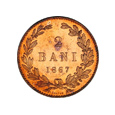VARLAAM’S SERMON
Text: dr. Ginel Lazăr / photo: MNIR/project MANUSCRIPTUM
Varlaam’s Sermon or “Romanian Book of Teachings for the Sundays over the Year, the Great Feasts and the Most Important Saints”, printed in Iaşi in 1643, is the best-known work written by the Metropolitan Bishop Varlaam of Moldavia, one of the great Romanian scholars and a founding father of the literary language. Considered by Nicolae Iorga “the most popular work of our old epoch“, the book is printed in Romanian in a Cyrillic alphabet, having 506 pages, illustrated with many religious Orthodox engravings (Biblical scenes, faces of saints), as well as illuminated initial letters, vignettes, ornamental initial letters, final decorations, etc. The book has two main parts. The former contains 54 sermons for Sundays, whereas the latter contains 21 sermons for the Great Feasts and the most important saints. The Preface addressed by the ruler Vasile Lupu to the Orthodox believers mentions that “this book in Romanian is offered as a gift to the Romanian language, first and foremost for praising God and, secondly, for teaching and benefiting the Orthodox souls“.
In its original form, Varlaam’s Sermon is a monument of the literary Romanian language, being printed in an elaborate and beautiful style, with ample sentences and figures of speech, enriching the sweet Romanian language in all the Romanians’ historical provinces, both in the cities and in the villages. This work is also the first printed book in Romanian in Moldavia in the 17th century, and its role is essential, namely delivering the message of salvation, not in a foreign language (i.e. Slavonic), but in the language of our ancestors. The religious book had a large circulation and an amazing impact, being useful both in schools and within the family, becoming, throughout time, the most read book in our old culture. It was widely spread in the intra-Carpathian Romanian provinces (Transylvania, Banat, Bihor, Maramureş), where 400 copies were found, very appreciated by the Romanian Orthodox believers, due to an elaborate form of expression in Romanian, close to the popular one.
In its collections, the National Museum of Romanian History preserves several copies of Varlaam’s Sermon,but each book has its own specificity and story. The volume that was the exhibit of April at NMRH has a special memorial value, related to the personality of St. Hierarch Pachomius from Gledin, the bishop of Roman. Pious Pachomius’s scholar and monastic activity is acknowledged in Moldavia, Transylvania and in the area of spiritual influence exercised by the Great Pecerska Lavra near Kiev, where he died in 1724. As a founder of the Pocrov Hermitage in the Neamţ County, Pachomius has also remained in our memory due to an important annotation, found as a footnote on the first pages of Varlaam’s Sermon. Thus, we find out that it was bought from the Pecerska Monastery by hieromonk Lazarus from the Pocrov Hermitage, who went to the Great Kievan Lavra to bring St. Pachomius’s remains to the country. The annotation, written in Romanian, but in the Cyrillic alphabet, explains the following: “This holy book, with good teachings and for great use to the souls, was bought by me, the pious hieromonk Lazarus, from Kiev, from the room in Pecerska where the books are sold at Podolia, when I went there to bring the remains of the late Pachomius, who was a bishop in Roman. Year 7234 (1725), September, the 16th day“.
Thanks to the kindness of the Father Superior at the Pocrov Hermitage, hieromonk Ambrozie Ghinescu, we could better interpret both significant details from St. Pachomius’s life and useful information related to the circulation of that copy from Varlaam’s Sermon to which this study is dedicated. His Holiness offered us a monograph dedicated to St. Pachomius, in a digital format, which he has recently written.
SAINT PACHOMIUS FROM GLEDIN.
The Odyssey of coming back to the Pocrov Hermitage
Born in the ancient village of Gledin in the county of Bistrița, Pachomius had become a true monk since his youth, being prepared for the monastic life at the Great Lavra in Neamț, which many people consider the oldest and most important monastery in Moldavia. As a preacher of quiet, Pachomius founded the Pocrov Hermitage, thus stating his love for Hesychasm and his need for a monastic life.
Pachomius was one of those monks who led the bishopric in Roman. His life of a saint is mentioned in the great prayer list of the Pocrov Hermitage and in the Chronicle of Roman and the Bishopric in Roman, written in 1874 by Bishop Melchisedec Ştefănescu. The saint’s life and activity became the subject of several monographs dedicated to Pachomius or to the Pocrov Hermitage.
The connection between the bishop of Roman and the Great Pecerska Lavra was facilitated by his Ukrainian exile, imposed by certain historical circumstances. Accompanied by a few disciples, Pachomius left the country because of a suspicion of betrayal and the accusation made by the ruler Mihail Racoviță. During all this time up to his death, he was in permanent contact with the Pocrov Hermitage. Unfortunately, from his correspondence with the ones in the country, only his testament has been preserved, together with some books.
From Bishop Melchisedec Ștefănescu (1823 – 1892), who visited the Pecerska Lavra in 1885, we find out that St. Pachomius spent in Kiev the last eight years of his life, namely the period between 1717 and 1724 (he died on the 26th of April 1724). He was buried in front of the great doors of the Pecerska monastery. This important testimony is mentioned in detail on the lid of the box that contained the relics of St. Archdeacon Stephen, taken to Kiev by Bishop Pachomius of Roman (it is about the saint’s finger, which was initially preserved at the Neamț Monastery).
When he died, St. Pachomius left a testament, currently preserved at the Romanian Academy, in which he expressed his great desire to come back to Pocrov. Taking his last will into consideration, Hieromonk Lazarus Ursu, Pachomius’s disciple, quickly left for bringing the saint’s relics back to the country. After a real Odyssey, which took place at least during 1725, St. Pachomius rests today in the hermitage he founded, at Pocrov. Hieromonk Lazarus Ursu’s journey is confirmed by the abovementioned annotation in Varlaam’s Sermon. This copy, bought from Kiev, later came into the possession of the Orthodox Parish in Apalina, Mureș County.
Before retracing the route of monk Lazarus from Kiev to the Romanian space, we must briefly present some data about Hieromonk Lazarus Ursu. He is believed to have been the nephew of the pious saint, a well-read scholar monk (who made many annotations, whose careful writing testifies for his intellectual formation), a disciple of Bishop Pachomius, as he calls himself in a note from 1735, which proves his vocation for monasticism. Educated and tonsured as a monk at the Neamț Monastery, founder of the Brătești and Ioneasa hermitages, he later becomes the Father Superior of the Neamț Monastery, which he administers for three years. Due to his spiritual and cultural abilities, Lazarus Ursu is proposed for the position of Bishop of Huși, but he piously turns down the offer to become a hierarch.
Going back to the journey in 1725, we must specify, as we infer from the content of the annotation, but especially from the historical context of the events, that it was necessary to establish a route for the return, so that he would not have raised any suspicion from the Moldavian authorities and the ruler Mihail Racoviță. This journey may not have lasted longer than October 1726, when Racoviță’s reign in Moldova ended. Thus, after solving the problem of taking St. Pachomius’s relics from the tomb in Pecerska, Hieromonk Lazarus Ursu bought Varlaam’s Sermon, mentioning there the completion of his mission on the Slavic land. Neverthless, the return route is revealed by another annotation in the Sermon, which continues the abovementioned one. So, we find out that monk Lazarus Ursu was in Transylvania, with St. Pachomius’s relics, on his way to Pocrov and, at a certain moment, he sold to priest Irimie from Apăfaia (Apalina, a neighbourhood in Reghin) the Sermon he had bought in Kiev. We can infer that Hieromonk Lazarus had run out of money for his journey and found this practical solution. Under these circumstances, we can assume that the return route established by the monk from Neamț was supposed to pass through Transylvania, from which, on unknown paths over the mountains, he could have got to Neamț County, at the Pocrov Hermitage.
In that epoch, a copy from Varlaam’s Sermon was sold in Transylvania for 20 or even 30 florins. Moreover, according to some side notes from such books, we find out that a Sermon could be purchased for the same price as a pair of oxen or ten sheep and eight lambs. If we take into account that a pair of good oxen cost on average 20 – 25 florins, we realize that a sermon was a small treasure for a Romanian household.
This is how Varlaam’s Sermon, bought from the bookshop of the Pecerska Lavra, containing annotations of great historical and memorial value, related to the remembrance of St. Pachomius, the Bishop of Roman, came into the possession of the Orthodox Parish in Apalina in Mureș County, sold by Hieromonk Ursu to the parish priest Irimie, because he urgently needed money to continue his journey towards Moldavia. The special context of the return of St. Pachomius’s relics from Gledin to Pocrov and their deposition in the church of the hermitage was shrouded in mystery, as proven by the fact that nothing was known about this ritual for a long time. Furthermore, when Bishop Melchisedec Ștefănescu went to Kiev, he noticed that Pachomius’s remains were no longer in the place where they had been buried, according to the inscription on the lid of the aforementioned box. This fact confirms the success of monk Lazarus Ursu’s mission, started in 1725.
When the flooring of the church of the Pocrov Hermitage was repaired, on 9 September 2013, the remains of a “pious monk” were discovered in the porch, at a relatively shallow depth. After anthropological investigations, it was established that the dead person’s body was not placed in an anatomical position, but in a way that certified the fact that it was reburied. For a higher degree of certainty, a post-mortem facial reconstruction was made and thus it was established that there was a great similarity between the resulting face and the one in the votive painting in the porch of the church of the Pocrov Hermitage.
On 14 April 2007, the Romanian Orthodox Church canonized the founder of Pocrov and the Bishop of Roman, also known as “the pacifier below Mount Chiriacu“, by the name: Saint Pious Hierarch Pachomius from Gledin. The ceremony took place in Gledin.














